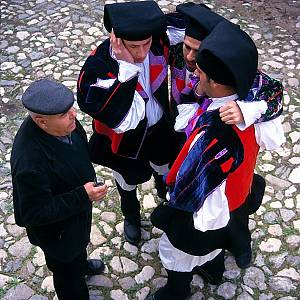Covid-19 forces people worldwide to change their behavior to avoid the epidemic’s spread as much as possible. Among the restrictions imposed by the pandemic, the physical distancing has had a significant impact on individuals’ lives and entire groups and communities. The canto a tenore is, in fact, multipart singing: four singers join the singing, each interpreting their specific vocal part. From the proxemic point of view and the reciprocal positions, our way of singing is characterized by the singers’ arrangement in a circle, a circle whose diameter is usually about one meter, inside which the singers are.
The distances are so well below the meter set by the actual social distancing rules. One of the singers, the soloist who guides the song, can move from the other three up to two meters away without significantly affecting the singing quality. Still, the other three singers always have to sing in close contact, touching each other with their bodies, often hugging each other to listen better and concentrate on the performance.
The physical proximity is necessary because a tenore singing still means reinterpreting and improvising a part of the song, following the other’s singers variations, proposing new movements; it is a song in which the chord is always created to support the singing of the other singers. It is not possible to sing one’s pre-established part, there are no scores for canto a tenore, and there is no conductor that directs the choir (if that were the case, it would no longer be canto a tenore).
It is impossible to sing with a protective mask because the guttural vocal emission (especially of BASSU and CONTRA) is incredibly complex and requires considerable effort that profoundly engages the phonatory and respiratory system. The air pressure on the vocal cords, on the false cords, and the larynx must be intense and constant and requires an equally strong and continuous inflow and outflow of air. This long introduction was necessary so that the reader can understand that the distancing between individuals prevents one from singing a tenore.
Thus, starting from the beginning of March 2020, in all the central and northern Sardinia towns, no one could sing a tenore anymore. The “canto a tenore” has, as happens with different musical expressions, two large macro-areas, or modes of execution. On the one hand, the spontaneous singing within the groups and communities mentioned above, performed in informal community contexts by some thousands of singers distributed in the various towns of central-northern Sardinia.
On the other hand, the “semi-professional” singing activity of stable groups performs in formalized and public contexts; in this second case, we are dealing with a few hundred singers gathered in over one hundred groups. The main context in which these groups perform is the stage of village festivals or country festivals almost always organized by citizens’ small societies to celebrate the patron saint. Due to the epidemic, all these village festivals were banned for a few months.
Even when the Italian government established protocols that allow the celebrations to occur without causing the spread of the virus, the civil societies that usually organize the festivals could not carry these latter on. These organizations were unable to guarantee the safety standards provided by the protocols.
The holiday period is mainly the one between May and September, with few exceptions in April and October, which is now in its final stages and has seen the festival stages’ silence and no official singing performance. Only in some cases, village festivals have seen the organization of the so-called “garas de poesia.” These latter are traditional clashes between improvisational poets and tenore groups traditionally accompany their performance. In these cases, the singing accompaniment’s repetitiveness allowed it to be carried out respecting the distances required by the law.
The designations employed and the presentation in the texts and documents referenced in this platform do not imply the expression of any opinion whatsoever on the part of UNESCO concerning the legal status of any country, territory, city or area or of its authorities or concerning the delimitation of its frontiers or boundaries.
